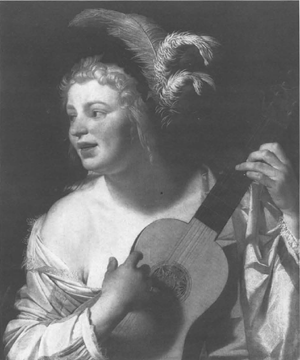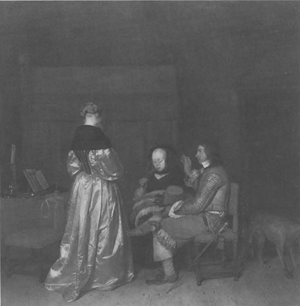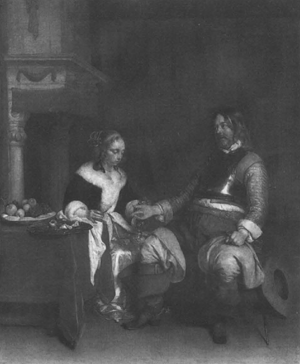De Zeventiende Eeuw. Jaargang 15
(1999)– [tijdschrift] Zeventiende Eeuw, De–
[pagina 24]
| |
René van Stipriaan's concept of the ludic in seventeenthcentury Dutch farces and its application to contemporary Dutch painting
| |
[pagina 25]
| |
nomena that share characteristics with the farce can signify in accordance with this ludic paradigm. Chief among them are seventeenth-century Dutch genre paintings.Ga naar voetnoot3 For obvious reasons, he could not address the functional parallels between painting and the farce in any great detail. Nevertheless, his study contains a wealth of valuable insights, insights that warrant further attention. For instance, he argues that the qualities of ambiguity, deception and veiling that are so central to the farce are likewise present in contemporary genre paintings. These qualities manifest themselves in genre paintings' veiled and enigmatic meanings, their thematized ambiguity, and the prominent roleplaying of figures depicted therein. In fact, ambiguity in genre painting extends to its very surface, to its masterful yet ultimately fictive display of a trompe-l'oeil reality. Moreover, Van Stipriaan observes that like farces, genre paintings often involve the presentation of protagonists from whom elite viewers would perceive a social distance, one which serves to confirm the elevated status of the latter. Therefore, it is scarcely credible to claim that such images express a categorical condemnation of activities involved therein. As is the case with farces, the primary purpose of genre painting does not lie in imparting moral lessons to contemporary viewers. Rather, it is a ludic one that serves to sharpen the wit through means of entertainment. There is much merit to Van Stipriaan's hypotheses; in fact several of them have been corroborated by recent research conducted on seventeenth-century Dutch genre paintings by art historians.Ga naar voetnoot4 Other aspects of his hypotheses, however, must be more closely investigated. Perhaps the most expeditious manner in which to analyze Van Stipriaan's theories in more detail as well as the relationship of the farce to Dutch genre painting in general is to utilize some specific examples of the latter. This discussion is best framed around paintings of prostitution for prostitutes frequently appear in early seventeenth-century Dutch farces as well as in contemporary genre paintings. More specifically, I will focus on the work of the Utrecht Caravaggisti, who as a group, surely rank among the most prolific painters of the subject of prostitution.Ga naar voetnoot5 Although the Utrecht Carvaggisti's depictions of prostitution are numerous, like all Dutch seventeenth-century paintings, they are conventional.Ga naar voetnoot6 What is meant by the term ‘conventional’ is that the Caravaggisti depicted only a limited number of themes associated with prostitution, ones which they repeated with tremendous frequency. Among the most popular were fanciful ‘portrait-like’ depictions of individual prostitutes (for example, Fig. | |
[pagina 26]
| |

Fig. 1 Gerrit van Honthorst, The Guitar Player, canvas, 82 × 68 cm, Paris, Musée du Louvre (Photo: Réunion des Musées Nationaux, Paris).
1);Ga naar voetnoot7 representations of a prostitute, with or without a procuress, interacting with an individual client (for example, Fig. 2);Ga naar voetnoot8 and larger-scale brothels, a theme typically involving four or more figures in various, disreputable activities (for example, Fig. 3).Ga naar voetnoot9 | |
[pagina 27]
| |
If we examine these depictions of prostitutes from the perspective of Van Stipriaan's hypotheses concerning the functional parallels between paintings and farces, the following observations can be made. Van Stipriaan's assertion that genre paintings like farces often involve the presentation of protagonists from whom elite viewers would perceive a certain social distance is undoubtedly correct.Ga naar voetnoot10 And, as is the case with farces, one can argue that the primary purpose of genre paintings (at least those representing prostitutes) was likewise not to impart moral lessons to contemporary viewers. Unfortunately, scholars have traditionally placed images such as those illustrated in this essay within a Calvinistic context which necessitates predominantly moralizing readings.Ga naar voetnoot11 If paintings of brothels were indeed intended to admonish viewers then we must conclude that artists figuratively operated ‘in league’ with Reformed ministers to produce effective didactic instruments for the moral improvement of their patrons. But if this were true then why did these very same preachers so strenuously object to what one of them, Willem Teellinck, termed ‘indecent or idolatrous paintings’?Ga naar voetnoot12 The collective pastoral censure of lewd art militates against the longstanding view that brothel scenes primarily served to make Calvinist morals visible. In fact, it is fascinating that indecent or idolatrous paintings were invariably lumped together with all forms of ludic culture in stern pastoral condemnation, for example, dancing, gambling, drinking and attending the theatre.Ga naar voetnoot13 Therefore, it is scarcely credible to maintain that such images express a categorical condemnation of activities involved therein. Moreover, it seems inconceivable that elites, already deemed inherently honorable and virtuous in contemporary society by deference of their social standing, purchased paintings, or attended performances - or read the published versions of farces - out of some pressing need for moral edification. If most depictions of prostitution are not primarily moralistic then how were they understood by well-to-do, seventeenth-century audiences? These pictures provocatively and palpably display sexy women and clients who most assuredly can be identified with a social class lower than that of the viewer. Moreover, they frequently include additional pictorial elements that serve as ingredients of seduction, among them, specific drinks | |
[pagina 28]
| |

Fig. 2 Dirck van Baburen, The Procuress, canvas 101,5 × 107,6 cm, Boston, Museum of Fine Arts (Photo: Museum).
and foods, especially oysters, a mollusk purported to be a potent aphrodisiac.Ga naar voetnoot14 Lastly, the consummate artistic illusion of the pictorial surface is inherently seductive. This is particularly true of the examples illustrated in this essay, examples that seductively play upon the pictorial palpability of the female anatomy. Consider, for example, the woman in Van Honthorst's Guitar Player (Fig. 1) whose breast, which would otherwise be exposed in her state of deshabilité, is playfully and tantalizingly hidden by her hand and the outer edge of the guitar; or the prostitute in Van Baburen's Procuress (Fig. 2), whose breast and nipple are crushed by her heavy bodice and lute; or Van Bijlert's Procuress (Fig. 3), in which a client fondles the breast of a prostitute who gazes at the viewer. | |
[pagina 29]
| |

Fig. 3 Jan van Bijlert, The Matchmaker, canvas, 103,5 × 154,5 cm, Lyon, Musée des Beaux-Arts (Photo: Copyright Studio Basset).
All of these factors, namely, the social distance of the viewer from the figures that are represented, the general lack of emphasis on didacticism, and, to the contrary, the visualization and at times the affirmation of erotic pleasure in paintings of prostitution, all suggest strongly that these pictures were purchased for their ludic value. What for a devout Calvinist would amount to a sort of pictorial anathema was for well-bred viewers, whose honor and virtue were inherent to their high station, an amusing and witty display of the dishonorable proclivities of their social inferiors.Ga naar voetnoot15 And part of the entertainment provided by the painting is the opportunity it affords the discriminating viewer to unravel precisely how the unwitting clients of the prostitutes are deceived. The painting by Van Bijlert (Fig. 3) is typical in this regard as we see a client who does not realize that he has been robbed (by a young child in the center of the canvas) because he is so preoccupied with the coins he has presumably laid on the table in payment for the services of a prostitute whom he fondles. Despite the many convincing correspondences that Van Stipriaan hypothesizes be- | |
[pagina 30]
| |
tween farces and paintings, the question nevertheless remains of the extent to which the qualities of deception, ambiguity, veiling, etc..., that were so pervasive in farces, are relevant in the pictures illustrated here (and, naturally, others representing the same subject as well). In connection with the stunning pictorial effects in the three examples just highlighted, one can certainly speak of the deceptiveness of the paintings' surface, that is, its presentation of a plausible yet ultimately fictitious reality, a quality fundamental to seventeenth-century Dutch art.Ga naar voetnoot16 Moreover, as Eric Jan Sluijter has pointed out, artists depicted alluring temptresses whose very seductiveness embodies the artistic techniques that engendered them.Ga naar voetnoot17 Beyond the deceptiveness of the pictorial surface the correspondences between farces and paintings - at least with respect to early seventeenth-century paintings - become more tenuous. The problem is fundamentally one of how farces signify versus how paintings signify. The ambiguity, masking of meaning, and deceptiveness of farces is communicated primarily through the gradual unfolding of the plot and especially the manipulative and deceitful language employed by the protagonists. It is communicated less through appearance though the appearances of characters in plays can obviously be quite deceitful. The viewers or readers of a farce, at least those with the capacity for discrimination, gradually discern the protagonists' true manipulative nature through their words and deeds. Versus farces, paintings only have recourse to visual phenomena, that is, appearances, to signify and unlike farces, narratives in paintings are entirely fixed and rigid, even if both the former and latter rely on stock character types.Ga naar voetnoot18 Therefore, the inherent degree of ambiguity and deceit in the visual arts in this early period is far less pronounced and far less sophisticated than that of farces. Although depictions of prostitution can be considered ambiguous or deceitful because of their frequent and clever juxtaposition of the nubile flesh of prostitutes versus the withered skin of the procuresses, I would still argue that in general, early seventeenth-century paintings tend to be more transparent than contemporary farces.Ga naar voetnoot19 There is little that is veiled or concealed in these artistic depictions. In depictions of prostitution what is striking is the incessant repetition of highly conventional motifs such as buxom whores, strong drink, | |
[pagina 31]
| |

Fig. 4 Gerard Terborch, The Paternal Admonition, 71 × 73 cm, Amsterdam, Rijksmuseum (Photo: Museum).
music-making, and highly specific foods, especially oysters.Ga naar voetnoot20 The erotic meaning of these motifs in art and in life in general were scarcely ambiguous to seventeenth-century viewers. Thus, in some respects, early seventeenth-century depictions of brothels are as coarse and raucous as they were obvious. However, as the century progressed, the manner in which brothel paintings - and other subjects as well - signify would gradually change in a direction that accords more fully with Van Stipriaan's concept of the ludic in farces. This can be demonstrated by briefly examining representations of brothels by one later seventeenth-century artist, Gerard Terborch, who was especially active during the 1650's and 60's. Among the many impressive aspects of Terborch's art are its uncanny narrative subtlety, its psychic nuance and tension created by scenes and situations left deliberately ambiguous. The quality of ambiguity in Terborch's oeuvre is perhaps best exemplified by his renowned painting, The Parental Admonition, known in two versions, in Amsterdam and Berlin (Fig. 4).Ga naar voetnoot21 The elegantly formal and decorous manner in which Terborch renders this scene has led to confusion about its subject that dates all the way back to Goethe.Ga naar voetnoot22 While this famous German poet was convinced that Terborch represented a domestic subject, later generations, particularly art historians in recent decades, have suggested that it may well rep- | |
[pagina 32]
| |

Fig. 5 Gerard Terborch, The Gallant Military Man, canvas, 68 x 55,2 cm, Paris, Musée du Louvre (Photo: Réunion des Musées Nationaux, Paris).
resent a brothel scene.Ga naar voetnoot23 Recently, Alison Kettering has argued persuasively that this picture and related works by Terborch should be viewed in an ‘open-ended’, multivalent manner. Terborch accentuates their ambiguity and leaves it to the viewer to resolve what is depicted.Ga naar voetnoot24 Even Terborch's unequivocal depictions of brothels, such as the so-called Gallant Military Man (Fig. 5), feature ambiguous if not deceitful components.Ga naar voetnoot25 What for example are we to make of the woman in this painting who is being solicited by the soldier? Is she a prostitute or an innocent maiden? Her downcast glance and somewhat passive pose bespeak a certain modesty that may or may not be out of place here. Unlike the brazen prostitutes in paintings by the Utrecht Caravaggisti, but much like the wily prostitutes in farces whose appearances can initially deceive the audience, ambiguity and deceit reign in this seemingly unassuming figure and many others like her.Ga naar voetnoot26 | |
[pagina 33]
| |
Lastly, the shift toward heightened yet refined ambiguity in later seventeenth-century Dutch genre painting calls into question its relationship with farces.Ga naar voetnoot27 Van Stipriaan's hypotheses concerning the application of the ludic features of seventeenth-century Dutch farces to other meta-literary phenomena, especially art, are entirely plausible. However, it would seem that initially farces, and presumably other literary genres, surpassed genre painting in their ability to provide sophisticated entertainment. Paintings would in a sense only reach a similar level of achievement during the 1660's. Curiously, the end of that decade would witness the rise of the society Nil volentibus arduum.Ga naar voetnoot28 This group's advocacy of virtue, didacticism and order in theatrical productions would, as Van Stipriaan has observed, deprive theatre of many of its earlier ludic subtleties.Ga naar voetnoot29 Yet the only repurcussions that I can see for genre painting in the later seventeenth century are a continued decline in the production of the coarse imagery that earlier generations of elites so thoroughly enjoyed. After taking so long to ‘overtake’ the farce, painting of this period would remain richly ludic. Abstract - This article examines René van Stipriaan's concept of the ludic in seventeenthcentury Dutch farces with reference to contemporary painting. In his recent study Leugens en vermaak, Van Stipriaan places farces within the context of flourishing ludic culture in the Dutch Republic and argues that they primarily offered audiences complex plots revolving around themes of deceit and ambiguity. Van Stipriaan also applies his hypotheses to other metaliterary phenomena, principally paintings. The article therefore explores the manner in which his notion of the ludic in farces is germane to Dutch genre painting of the early and later seventeenth century. |
|

